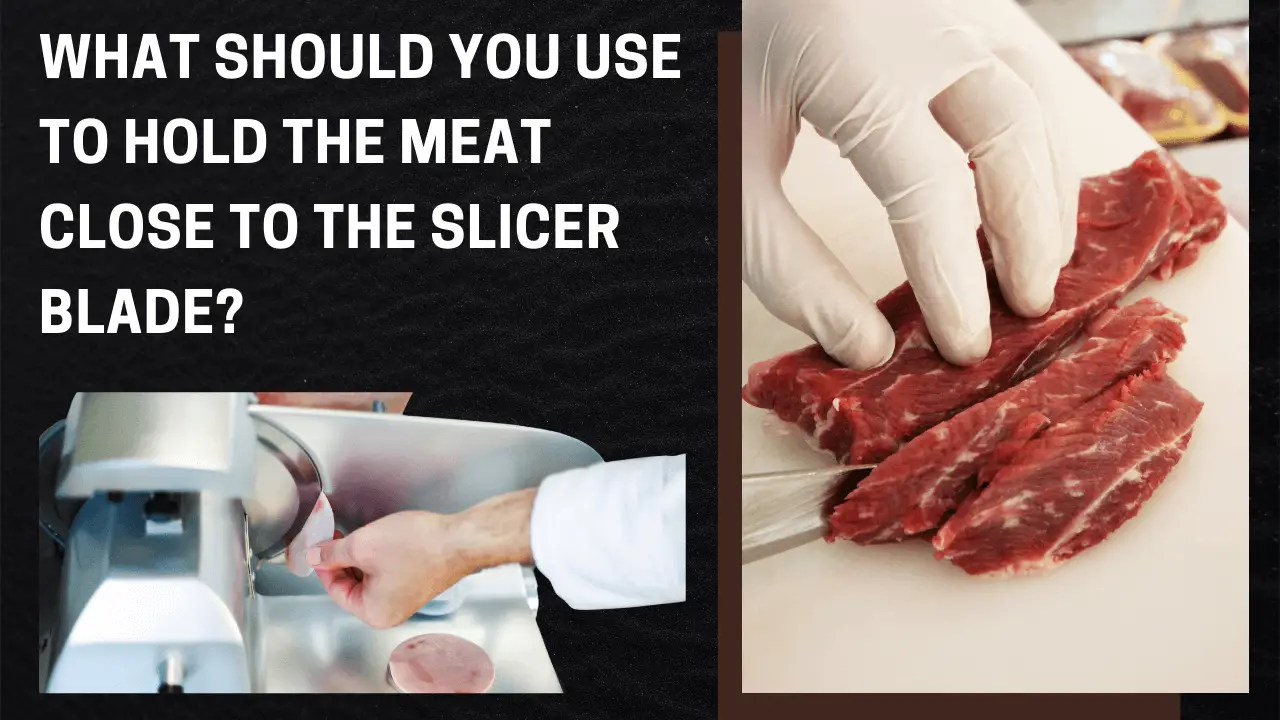Cleaning your wood cutting boards after handling raw meat is important for food safety. Rinse the board with warm water and use mild soap for deep cleaning. Regularly cleaning and sanitizing them can help reduce the risk of foodborne illness.
How Dirty Are Chopping Boards?
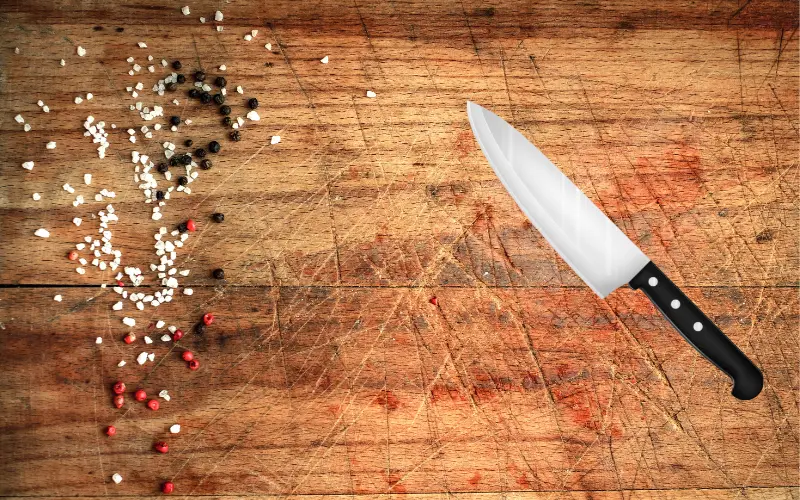
Chopping boards are some of the dirtiest items in any kitchen. Studies have found they contain E. coli and other pathogens like salmonella and listeria. Even after being washed with soap and water, chopping boards can still contain significant amounts of bacteria, making them a potential source of foodborne illness. To protect your health and the safety of others, it’s important to clean and sanitize your cutting boards regularly.
Cleaning Wood Cutting Boards After Raw Meat?
- Scrape off residue: Use a spatula or bench scraper to remove large food particles or residue from the cutting board.
- Rinse with warm water: Run warm water over the board, concentrating on the areas where raw meat was in contact.
- Apply mild soap: Using a sponge or soft brush, gently scrub the cutting board with a small amount of mild dish soap.
- Rinse thoroughly: Rinse the board under warm water, ensuring all soap residue is removed.
- Sanitize the cutting board: Mix 1 tablespoon of unscented chlorine bleach in 1 gallon of water. Apply the solution to the cutting board, let it stand for a few minutes, then rinse with warm water.
- Dry the cutting board: Pat the board dries with a clean cloth or paper towel. Allow the cutting board to air dry completely by standing it upright, away from direct sunlight or heat sources.
Routine Cleaning And Care For Wood Cutting Boards
To maintain the cleanliness and longevity of your wood-cutting board, follow these routine care tips:
- Clean after each use: Always clean the cutting board, following the above steps. Regular cleaning will help prevent bacterial growth and cross-contamination.
- Oil your cutting board: Once a month or as needed, apply a thin layer of food-grade mineral oil or cutting board oil to the surface of the wood. This will help maintain the board’s moisture balance and prevent cracking or warping.
- Avoid submerging in water: Do not submerge your wood cutting board or wash it in the dishwasher, as excessive moisture can cause the wood to warp or crack.
- Store your cutting board properly in a dry, well-ventilated area away from direct sunlight or heat sources.
Reviving And Restoring A Worn Wood Cutting Board
If your wood-cutting board starts to show signs of wear, use these techniques to restore it:
- Remove stains: Mix a paste of 1 part baking soda, 1 part salt, and 1 part water. Apply the paste to the stained area and gently scrub with a sponge or soft brush. Rinse thoroughly with warm water.
- Remove odors: Sprinkle the cutting board with coarse salt and rub it with half a lemon. Allow the mixture to sit for a few minutes, then rinse with warm water.
- Resurface the cutting board: If the cutting board has deep grooves or knife marks, sand the surface using fine-grit sandpaper. After sanding, rinse the board with warm water and dry thoroughly before applying a layer of food-grade mineral oil.
When To Replace Your Wooden Cutting Board?
Wooden cutting boards, like all kitchen utensils, should be replaced at some point due to wear and tear. After using your wooden cutting board for raw meat, it is important to assess its condition to determine if it needs to be replaced. If the cutting board’s surface has deep scratches or cuts or has become warped, it should be disposed of and replaced.
Safety Tips For Wooden Cutting Boards
- Always wash a cutting board between uses.
- Use mild dishwashing soap, detergent, and warm water to clean the board.
- Thoroughly rinse the board with clean hot water after washing it, then let it air-dry completely before you put it away.
- For extra sanitation, use a solution of 1 tablespoon (15 mL) of chlorine bleach per gallon (3.8 liters) of water to sanitize the cutting board after it’s been washed.
- Use a clean cloth or paper towel to apply the bleach solution and let sit for 30 seconds before rinsing with hot water.
- Using a wooden cutting board, you mustn’t submerge it in water or put it in the dishwasher to clean it. These methods of cleaning can cause the wood to warp and crack.
- For extra wear and tear, use mineral oil to condition your cutting boards after each wash, which will help them last longer.
- Re-oil your cutting board as needed, depending on how much wear and tear it gets.
- Regularly inspect the cutting board for cracking or damage; replace it with a new one if necessary.
- If you have to cut raw meat on the wooden cutting board, use a separate one for other foods such as fruits and vegetables.
- Wooden cutting boards should be replaced every few years, depending on how often they’re used and how well-maintained they are.
- It’s also important to store the board properly; air-dry it and avoid moisture, which can cause wood warping or splitting.
- Keep your wooden cutting boards away from heat sources like hot pans, which can damage them over time.
FAQs
What is safer: plastic or wood cutting boards?
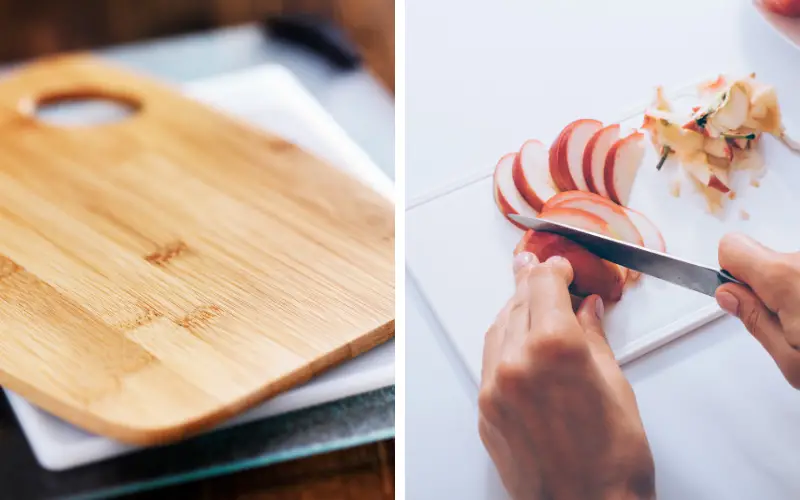
Wood cutting boards are generally better for food safety due to their porous nature. The bacteria from raw meat can get embedded into the board, and plastic won’t absorb as easily. But both materials should be cleaned and disinfected with raw meats or other potentially hazardous ingredients such as poultry or seafood after every use.
What are the different materials used for a cutting board?
Cutting boards may be made of plastic, wood, bamboo, or composite materials such as Corian. Each material has its own advantages and disadvantages. Plastic cutting boards are easy to clean with hot soapy water and do not absorb odors like other materials. Wooden cutting boards are less likely to dull knives quickly but can become stained and absorb odors. Bamboo cutting boards are eco-friendly but may be more difficult to clean and sanitize. Composite materials such as Corian are known for their durability and non-porous surfaces, but they can also be expensive.
What you should not put on a wooden cutting board?
A few items to avoid are citrus, tomatoes, and other acidic fruits and vegetables. These can cause stains and damage to the wood. You should also not use a wooden cutting board for raw fish as these will be harder to clean after use and could potentially lead to bacterial contamination of the board.
Are wooden cutting boards waterproof?
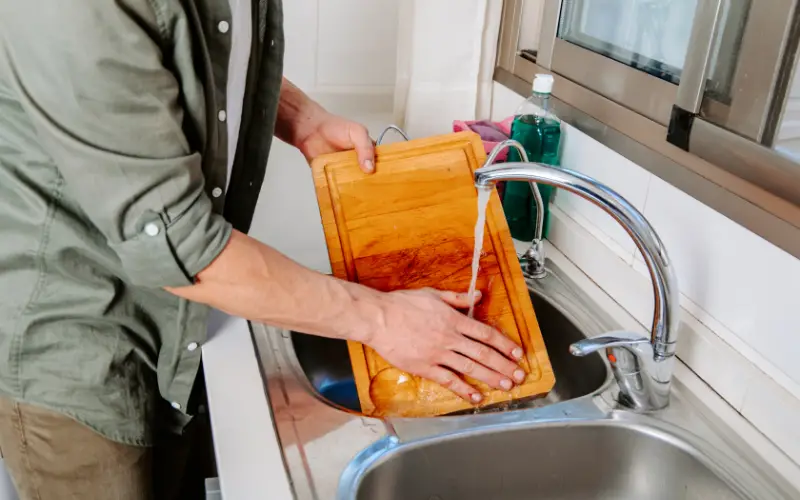
No, wooden cutting boards are not waterproof. Water can penetrate the wood, causing it to become warped and discolored. To avoid this, dry off moisture immediately after washing your cutting board. It would also help to periodically oil your cutting board to keep it sealed and prevent water damage.
Do wooden cutting boards smell?
Yes, wooden cutting boards can develop a smell from use, especially after handling raw meat. This odor is caused by the build-up of bacteria that can occur when wood absorbs liquids, fats, and oils.
What are the worst surfaces for cutting boards?
Hard plastic, glass, stone, and steel are some of the worst surfaces for cutting boards. These materials can cause knives to become dull quickly and can be difficult to clean, as they don’t absorb moisture or bacteria. Additionally, these surfaces do not provide enough traction for a knife blade, making cutting items properly difficult.
Conclusion
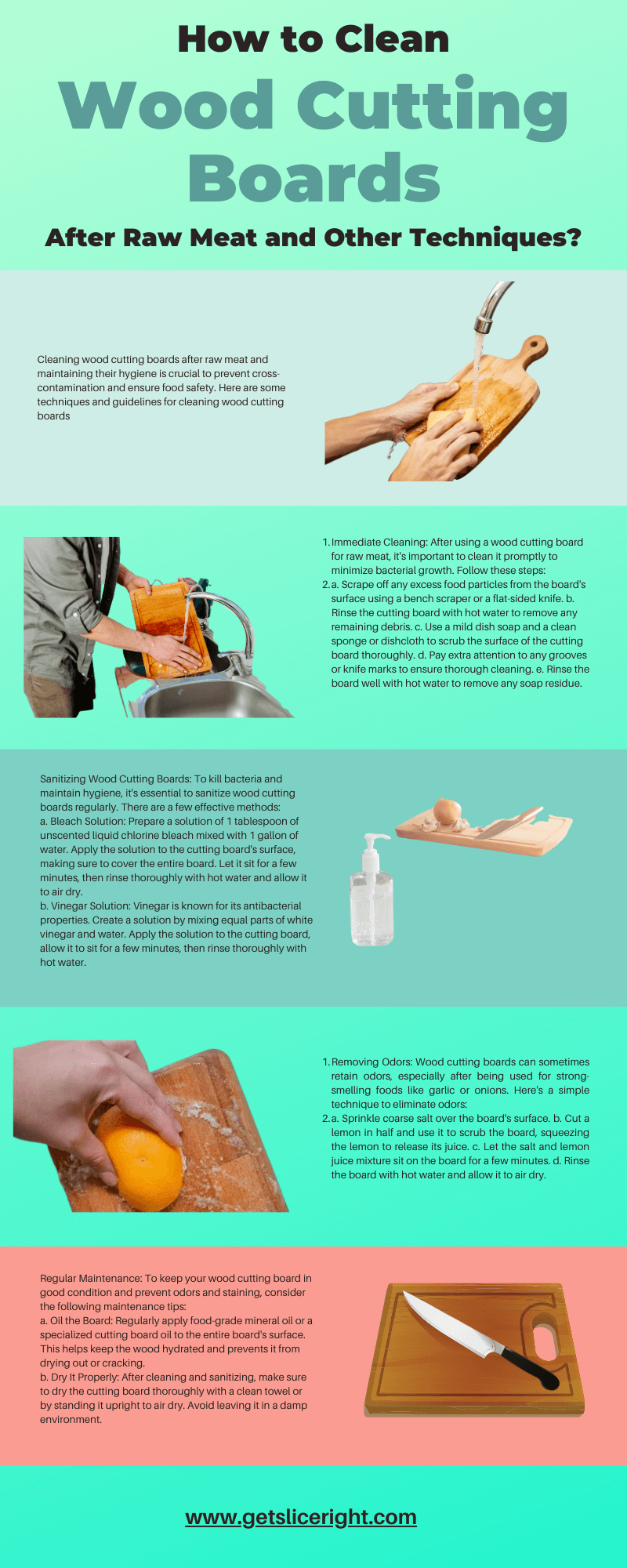
Cleaning wood cutting boards after raw meat is a very important task. Taking the proper steps to clean your cutting board can help prevent bacterial contamination and food-borne illnesses. Use soap and hot water, chlorine or vinegar rinse, hydrogen peroxide, or bleach for disinfection. It’s important to regularly condition your cutting board to keep it in good shape. Always separate boards for raw and cooked foods, and never put them in the dishwasher. These steps will ensure that your wood-cutting boards remain safe and clean for food preparation.

Mario Batali is a renowned author, food enthusiast, and passionate chef who has dedicated his life to exploring the world of culinary arts. With a love for sharing his knowledge and experiences, Mario has become a prominent figure in the food blogging community, inspiring countless readers with his creativity and expertise.
In addition to his culinary prowess, Mario Batali is also a talented writer with a flair for engaging storytelling. He launched his own food blog to share his recipes, cooking tips, and personal experiences in the kitchen. Over time, Mario’s blog gained a loyal following of food enthusiasts who appreciate his unique approach to cooking and his dedication to using only the finest ingredients.
Mario Batali’s passion for food and his commitment to sharing his knowledge with others have made him a true inspiration in the world of culinary arts. Through his blog, cookbooks, and public appearances, Mario continues to spread his love of food and the joy of cooking with his ever-growing fanbase.


